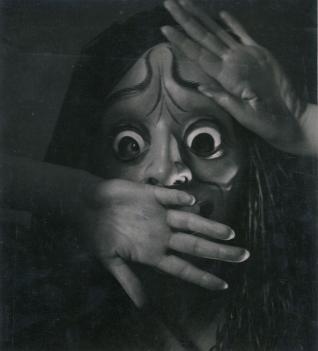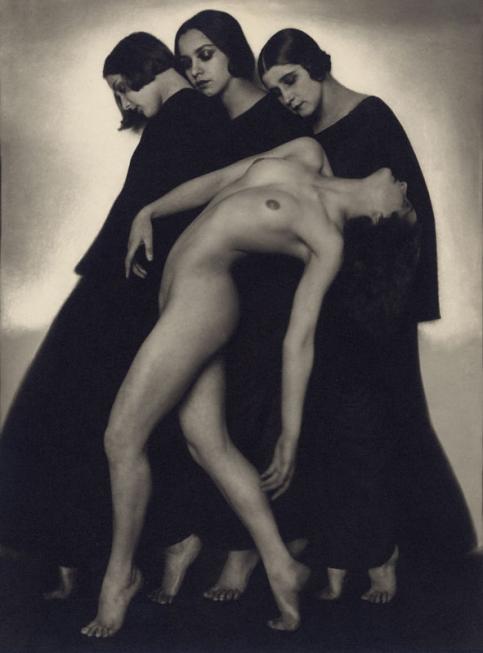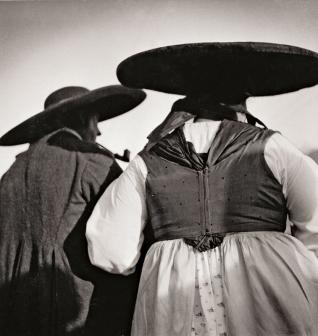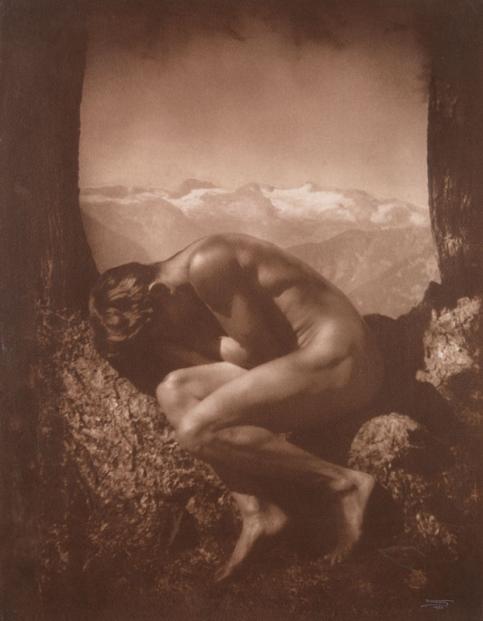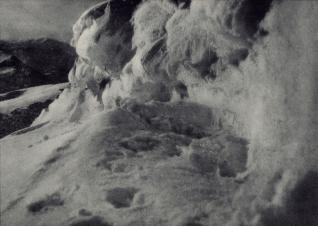Heir to the Viennese Jugendstil and Pictorialism, the photographic work of Rudolf Koppitz [1884-1936] magnifies the body in movement in elegant compositions that have become iconic in the history of photography. The “Rudolf Koppitz [1884-1936]” exhibition is the first big retrospective of the photographer’s work in France. It was curated by the Photoinstitut Bonartes, Vienna and brings together almost 130 photographs and documents in one unique exhibition at the musée Nicéphore Niépce.
In 1929, the first ever article on art photography was published in the Encyclopaedia Britannica . The illustration used was a photo by Rudolf Koppitz, Movement Study : we see three women draped in black in front of whom is a fourth young woman, nude, leaning backward in an elegant and controlled stance. This photo has since become a veritable icon for the way it incarnates art photography and seems to come from another time when modernity was expressed through the Nouvelle Vision and Surrealism. It was in this context nevertheless that Rudolf Koppitz [1884-1936] would become one of the main figures of Viennese pictorialism. This international movement came to be in the 1880s with groups of rich amateurs in clubs claiming the status of art for photography as a whole. To do so, it put the emphasis on what it referred to as “noble” forms of printing, inspired by painting and the graphic arts: pigmented prints, using gum bichromate, oil… The pictorialists refused the purely mechanical reproduction of the real by stylising, interpreting, blurring…
Koppitz was one of the representatives of this aesthetic. His position as teacher then director of the photographic department at the Vienna Graphische Lehr- und Versuchsanstalt [ The Institute for applied graphic arts] allowed him to exercise an influence on Viennese photographic output in general. He participated in a number of exhibitions and this, as well as presiding over selection committees, conferred a certain authority on him in art photography circles. Koppitz’s themes throughout his life are evidence of his predilection for nature and physical exercise, with an attachment to the principles of naturism that appeared at the start of the century. His depiction of nudes, including of his own body, reflected an aesthetic quest for strength and purity.
In the early thirties, Koppitz shifted away from pictorialism and adopted a more documentary, but still carefully staged style. He travelled the countryside in search of peasant authenticity. These images of the Austrian “Heimat” became popular at a time when there was an attempt to increase tourism: the State wished to depict an ideal homeland, a country of beautiful Alpine landscapes, and keeper of traditions.
[The term “Heimat” has no real equivalent in English. It reflects the notion of the homeland, native land, country, but also evokes a place that feels like “home”].
Koppitz’s aesthetic vocabulary was adopted by the Austro-fascist powers and the supporters of National Socialism. Koppitz’s own political opinions remain unclear, he died two years before the Anschluss. We are more familiar with those of his wife Anna, also a photographer and his assistant, who took a number of shots of Austrian and German youth that are aesthetically reminiscent of the work of Leni Riefenstahl. She continued to exploit her husband’s work after 1936 and by associating her own photos and her links to the Nazi regime doubtless contributed to damaging Koppitz’s reputation in the long term. Was Rudolf Koppitz naive or merely guided by his artistic and aesthetic quest? His works have a timeless and theatrical beauty that earned him the praise of his peers and a level of popularity for his nudes and dance photographs that has lasted until now.
BIOGRAPHY
Rudolf Koppitz was born on January 3rd 1884 in Austrian Silesia [in the current Czech Republic] into a German-speaking family.
1897-1907
The young Rudolf became an apprentice to the photographer Robert Rotter in Freudenthal. In 1901, the young man, who was then 17 years old, passed his professional aptitude certificate and got a job in Florian Gödel’s studio in the main part of the Opava district. A year later, he moved to Brno, where he worked retouching on positives and negatives in Carl Pietzner’s famous studio.
1908-1911
In the following year, Koppitz worked for a number of different photographers throughout the country. He moved to Vienna in 1911. His first dated photographs, taken in his spare time, go back to 1908; they are of the Minoriten and St. Charles’ churches in Vienna, picturesque landscapes or cragged mountain views. His style was influenced by painting and the graphics of Art Nouveau and the Viennese secession, as well as those of the photographers of the pictorialist movement that he must have seen on show in Vienna. However, there is nothing to prove he had any direct connection with these various movements.
1912-1913
At the age of 28, Koppitz took a new direction in his photographic career by taking a course at the Vienna Graphische Lehr- und Versuchsanstalt [ The Institute for applied graphic arts]. He followed the specialist course by Novak on the artistic photographic portrait. Novak’s evident taste for the ornamental and his predilection for stylised compositions and the way he worked spaces in light and dark sections, had a lasting effect on Koppitz. In 1913, Koppitz was hired as an assistant for “portrait and landscape photography and retouching”. He preferred to work with the techniques of “noble” printing, that he continued to perfect, and tended to choose typicalpictorialist subjects: snow-covered landscapes, trees, veduta
, romantic country scenes and many portraits. He travelled through Europe, notably to Holland and Italy, where he took many photos.
1914-1918
Koppitz was drafted right from the start of the war and had to interrupt his work as assistant. He was made sergeant in a company of pilots and named “master assistant for field photography”. He first served on the Eastern front before being transferred to the photographer reconnaissance training site in Wiener Neustadt. The photos that remain from this time represent the Galician front that Koppitz romanticised in his characteristic style. Shots he took from his planes are clean, geometric, modern compositions and stand out clearly from the rest of his work.
1919-1927
When the war ended, Rudolf Koppitz went back to his job at the Institute for applied graphic arts. He was first the “master assistant for retouching”, then became a fully-fledged teacher in 1920. He became a member of the Photographic Society. In 1924, his first big personal show was held at the Vienna Chamber of Commerce. He began actively participating in other shows: up until his death, his work was seen in almost 60 shows in Austria and abroad. He met Anna Arbeitlang at the Institute, where she had been working as an assistant since 1917. They were married during the summer of 1923. Koppitz took his first nude photos in collaboration with his young wife. In early 1925, Koppitz produced his best-known work, Bewegungsstudie
[Movement study], that went on to be an international success. During this creative phase, he worked with a number of dancers. He notably photographed the members of the Russian dance troupe “Issatschenko Ballet” twice.
1928-1929
Koppitz did not just participate in international amateur photography exhibitions, as a committee member he also decided who else got a chance to participate in this type of event. He was part of the staff of the magazine Der Lichtbildner and this, as well as his numerous other photographic contributions to other trade magazines Photo- [und Kino-]Sport
or Photographische Korrespondenz
, meant he had quite a level of influence in the contemporary photography field in Austria.
1930-1935
In 1930, the international “Film und Foto” [ FiFo] exhibition took place in Vienna. Koppitz’s style changed: the symbolist compositions were replaced by shots that were more documentary and objective. He no longer used complicated printing process and shifted away from the pictorialist blur. His favourite motifs remained country life, landscapes and sport.
1936
“Land und Leute” [ The Country and the People], was Koppitz’s biggest and final exhibition, inaugurated at the Museum of the Applied Arts [now the MAK] in Vienna in February 1936. Over five-hundred pieces were exhibited with motifs depicting a romanticized view of rural life in Austria and South-Hungary.
Rudolf Koppitz died on July 8th 1936 at the age of 52. Anna Koppitz administered his heritage and continued to work as a photographer, especially during the Nazi era.


